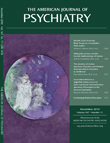Relief From Chronic Intractable Auditory Hallucinations After Long-Term Bilateral Theta Burst Stimulation
To the Editor: Auditory hallucinations in patients with schizophrenia are severely distressing and increase the risk for violence and suicide. In up to 25% of patients, such hallucinations resist therapeutic efforts. Repetitive transcranial magnetic stimulation (rTMS) to the left temporoparietal cortex has been established as an effective new treatment option (1, 2). However, the effectiveness and sustainability of this treatment are still under debate. Bilateral stimulation and prolongation of the treatment course might enhance the size and maintenance of the effect. The use of continuous theta burst stimulation, a patterned form of rTMS with brief stimulation sessions, could improve clinical practicability (3). We report on the case of a patient who received continuous theta burst stimulation applied to the left and right temporoparietal cortex.
“Mr. C” was a 52-year-old right-handed man with a 22-year history of paranoid schizophrenia (consistent with DSM-IV criteria). The patient suffered from chronic, continuous, distressing voices that were resistant to different antipsychotics in correct doses for correct treatment periods as well as to cognitive behavioral therapy. Continuous theta burst stimulation was applied to the left and right temporoparietal cortex once per working day in the morning for 9 weeks (International 10-20 system for EEG electrode placement: between positions T3/P3 and T4/P4; 40 sec; three stimuli at 50 Hz every 200 msec; 80% active motor threshold). Treatment with clozapine (200 mg/ day) and amisulpride (600 mg/day) was continued. An EEG obtained before treatment showed clozapine-induced changes but no epilepsy typical signs. No side effects were noted. Auditory hallucinations were evaluated using the subjective Hallucination Chan ge Scale, quantifying the change of hallucinations around the baseline score of 10 from 0 to 20 (1). In the first week of treatment, the patient reported a suppression of auditory hallucinations for several minutes immediately after each stimulation (Hallucination Change Scale score: 9). Subsequently, he described a reduction of loudness in the second week (Hallucination Change Scale score: 7); longer periods without auditory hallucinations in the fourth week (Hallucination Change Scale score: 5); rare hallucinations in the fifth week (Hallucination Change Scale score: 3); and lasting, complete suppression from the sixth week onward (Hallucination Change Scale score: 0). His score on the Positive and Negative Syndrome Scale decreased from 93 to 61 (positive subscale score: 27→11, negative subscale score: 25→22, general psychopathology subscale score: 41→28). His score on the Global Assessment of Functioning increased from 42 to 55. Weekly evaluation of hallucinations confirmed their continuous absence for 3 months.
The observation in the present case provides the first evidence, to our knowledge, that a long-term bilateral application of continuous theta burst stimulation can achieve a complete and long-lasting elimination of auditory hallucinations and an improvement in global function. Of note, an amelioration of delusions, anxiety, tension, and unusual thought content was also accomplished. Since auditory hallucination-associated cortical activities are not limited to the left hemisphere, we opted for bilateral stimulation to optimize efficacy. Notably, improvement was achieved gradually, with complete remission, pointing toward a benefit of prolonged treatment, not occurring until 6 weeks. As intended, continuous theta burst stimulation beyond remission was followed by maintenance of the effect. However, in addition to briefer treatment sessions, an advantage of continuous theta burst stimulation relative to rTMS cannot be derived from this report. Further trials are needed to disentangle the influence of treatment duration, laterality, and stimulation paradigm in order to determine treatment efficacy, clinical practicability, and sustainability.
1. : Transcranial magnetic stimulation of the left temporoparietal cortex and medication-resistant auditory hallucinations. Arch Gen Psychiatry 2003; 60:49–56Crossref, Medline, Google Scholar
2. : Should we expand the toolbox of psychiatric treatment methods to include repetitive transcranial magnetic stimulation (rTMS)? A meta-analysis of the efficacy of rTMS in psychiatric disorders. J Clin Psychiatry 2010; 71:873–884Crossref, Medline, Google Scholar
3. : Theta burst stimulation of the human motor cortex. Neuron 2005; 45:201–206Crossref, Medline, Google Scholar



